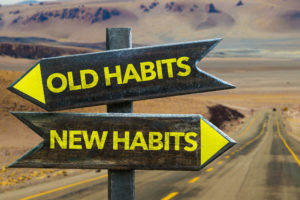
Kate’s focus is not on defining good nutrition. Instead, Kate helps her clients take one meaningful step forward. “For one person, this could mean increasing the amount of vegetables they eat from two to four servings a day. For another person, this could mean going from two sodas a day to two half sodas a day, to drinking a soda every other day, then once a week, and so on.”
Often, when a person gets to Kate, they have seen their doctor and may have received nutrition information from various sources. They may have the motivation to make a change, but they don’t know where to start, and they can be exhausted. Kate aims to understand a person’s unique goals and life situation. “I want to know where each person is at. When I can help to find a connection between why they’ve come in and how this may impact them in a tangible way, this is where I’ll see a tiny light bulb go off. This is the real first step to making positive change.”
Here are three tips from Kate to help you take the first step to rebooting your diet and establishing healthy eating patterns to improve your overall health.
All the Meals are Important, but Let’s Start with Breakfast
Does your breakfast hit the major food groups? According to Kate, two eggs, a slice of toast, and a piece of fruit can be one ideal way to start your day. Eating multiple food groups, including protein, in one meal supports satiety, or your feeling of fullness, and helps control blood glucose levels. This reduces the chance that you experience a sudden loss of energy and get tired soon after eating. Over time, the effects of consistently eating a healthy breakfast are compounded (i.e. more regulated eating patterns over the course of the day, weight management, sustained energy). Plus, eggs, toast, and fruit have minimal ingredients and contain healthy vitamins and nutrients like fiber that benefit your body. You can take these considerations forward to other meals in your day.
Snack Smart
Pay attention to your snacking routine. When do you snack, where do you snack, and why do you snack? Kate says that people often snack out of boredom or as a distraction. It becomes a habit when you walk through the kitchen or watch TV to grab a handful of pretzels. “Look at snacks as fuel instead of a habit or a tool to fight boredom.” Kate says to avoid snacking in places where you don’t want to snack, like at the computer or in front of the TV. “You want to try and break the connection between the television, for example, and your desire to snack. You can retrain yourself to make the choice to snack, rather than reverting to that handful of pretzels every time you watch Jeopardy.” Also, if you’re going to snack, sit at the kitchen table. The most effective snack will have a hit of protein and some carbohydrates. Try an apple and a handful of nuts, Greek yogurt, cottage cheese with fruit, and vegetables with hummus.
Ask Yourself: Why Do I Eat?
The most basic purpose of food is to fuel your body. Of course, food is more than energy. “Food is happy. It’s sad. It’s celebratory. It’s family.” Food is attached to so many occasions and gives us physical and emotional pleasure. “I tell my clients to eat foods that they enjoy eating, but to make sure to work at incorporating healthy options into their diet. Toss a handful of baby spinach into those breakfast scrambled eggs for example.”
Bonus Tip
A little sweet every now and then is a nice treat, but Kate advises watching your overall sugar intake. “Everyday, your body requires a certain amount of food. Let’s call this your body’s food budget. If 30% of your food budget it taken up with sugar, you are very limited in what else you can consume while staying within your daily budget.” An apple has natural sugars and other nutrients like fiber, potassium, and vitamin C. A can of soda does not.
Taking the Next Step
Kate says she often asks her clients these questions. What’s your answer to these three questions, and what’s your first step look like?
- Why do I want to change?
- Where would I like to be in my ideal level of wellness?
- What do I need to get there?